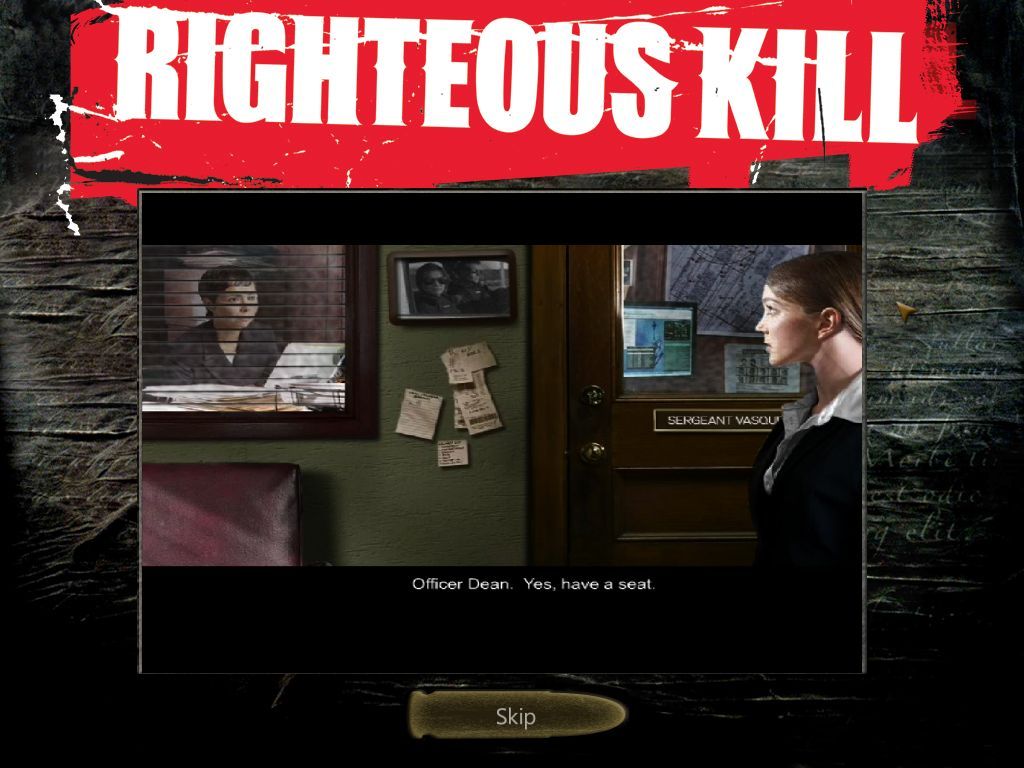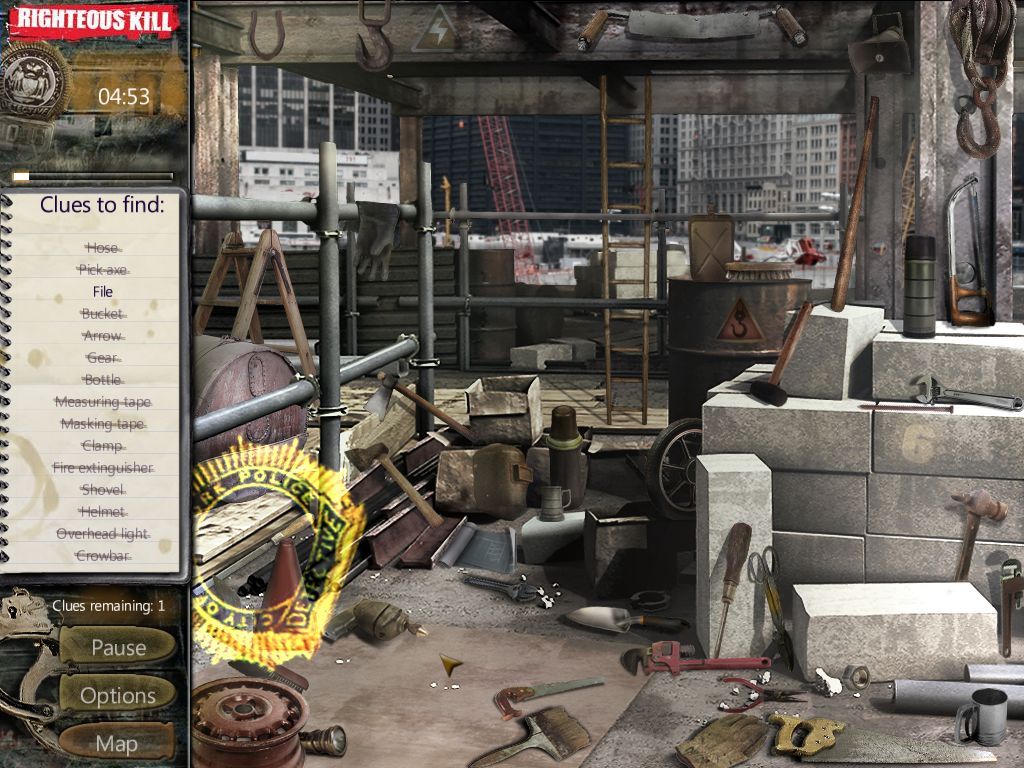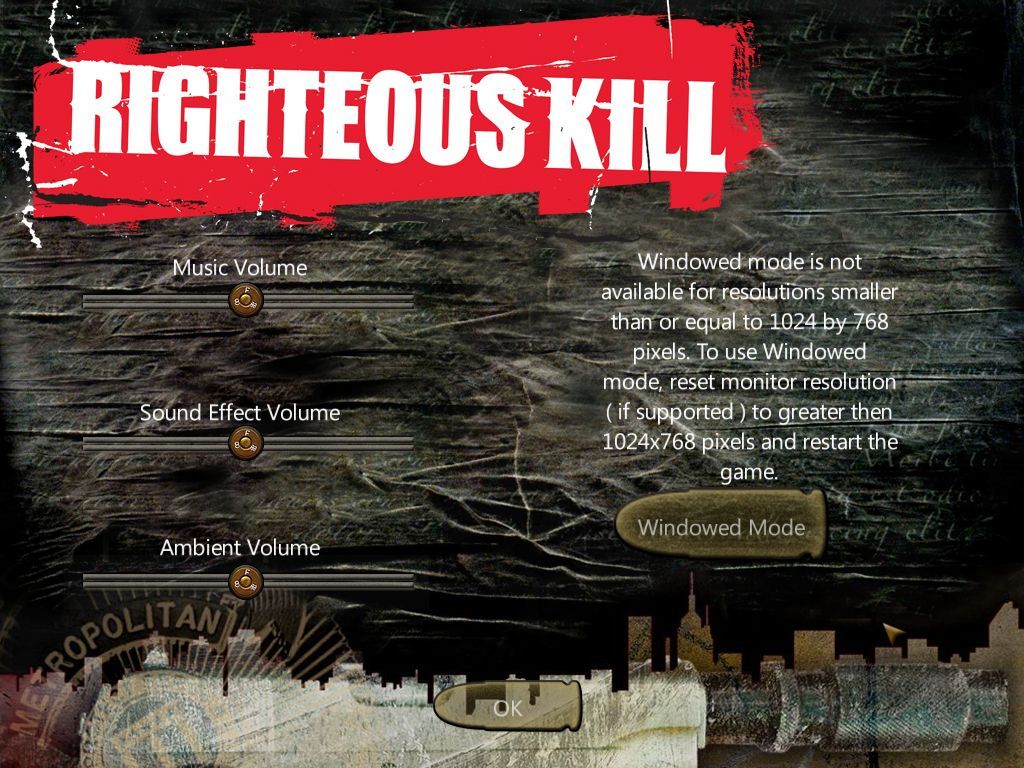Retro Replay Review
Gameplay
Righteous Kill embraces the classic hidden-object formula, presenting players with intricately detailed crime scenes littered with assorted items to locate. Objects are neatly listed along the left side of the screen, and your task is to click through the clutter before the clock runs out. The timed challenge keeps each level feeling urgent, and the carefully calibrated difficulty curve ensures that newcomers aren’t overwhelmed while veterans still feel tested.
(HEY YOU!! We hope you enjoy! We try not to run ads. So basically, this is a very expensive hobby running this site. Please consider joining us for updates, forums, and more. Network w/ us to make some cash or friends while retro gaming, and you can win some free retro games for posting. Okay, carry on 👍)
The UV flashlight hint system is a standout feature, seamlessly integrated into the investigative theme. When pressed, it bathes the scene in a soft, glowing light that reveals hidden items at the expense of a short cooldown. This unlimited-but-temporarily-recharging mechanic strikes a satisfying balance: you never feel completely stuck, yet you’re encouraged to sharpen your observational skills rather than rely solely on hints.
Between the main hidden-object stages, Righteous Kill peppers in a variety of mini-games that break up the search-and-find rhythm. You’ll dust surfaces for fingerprints in a gently swiping motion, reconstruct shredded documents puzzle-piece by puzzle-piece, and engage in “spot the difference” challenges using grainy security footage. These diversions reinforce the detective narrative and add welcome variety, preventing the core gameplay loop from becoming monotonous.
Progression feels rewarding, as successfully completing scenes unlocks new precinct locations, access to confidential case files, and fresh crime-lab gadgets. While there’s no branching path or choice-driven outcome, the game’s steady escalation—from suburban townhouse to shadowy subway tunnels—keeps motivations high. Occasional sudden time-extensions and bonus-object challenges also provide little fireworks of excitement for completionists.
Graphics
Visually, Righteous Kill delivers richly textured backdrops reminiscent of a gritty crime drama. Each scene is densely packed with props—shattered glass, overturned furniture, blood splatters—creating an authentic noir atmosphere. Careful attention to lighting helps objects pop against darker surfaces, which is crucial when you’re scanning busy environments under time pressure.
Character portraits and narrative interludes are rendered as stylized stills, capturing the tense expressions of the rookie detective and the shadowy figures he encounters. While there’s little full-motion animation beyond ambient flicker or rain effects, the static artwork is polished and evocative. Subtle particle effects—dust motes floating in beams of light, the soft glow of neon signs—lend an extra layer of immersion.
On modern hardware, load times are brief and the game maintains a stable framerate even in the most complex scenes. Zooming in to examine areas more closely remains fluid, preventing any jarring transitions. Although the graphics aren’t pushing the boundaries of 3D rendering, the high-resolution 2D artwork suits the hidden-object genre perfectly and never feels dated.
Story
The narrative thrust of Righteous Kill places you in the shoes of a fresh-faced NYPD detective assigned to the clandestine Vigilante Unit. Early briefings reveal a chilling case: a grieving husband is suspected of murdering the assassins who slaughtered his wife and daughter. This moral ambiguity—hero or villain?—serves as the game’s emotional backbone, propelling you through each scene with a sense of investigative purpose.
As you piece together clues, the game presents a series of diary entries, police transcripts, and crime-scene photos that gradually flesh out motivations and possible conspiracies. Writers have taken care to balance terse police procedural jargon with personal diary fragments, letting you glimpse the husband’s descent into vengeance and the detective’s own doubts about justice. For a hidden-object title, the story is surprisingly weighty.
While there are no branching dialogue trees or multiple endings, mid-level cutscenes and text-based revelations ramp up tension effectively. The husband’s lawyer makes a compelling cameo in one chapter, challenging your assumptions and keeping the narrative from becoming a simple cat-and-mouse chase. By the finale, you’ll find yourself questioning what it means to serve the law when your suspect’s grief is so tangible.
Overall Experience
Righteous Kill offers a tightly focused hidden-object adventure that marries genre-standard mechanics with a compelling crime-drama premise. The pacing never drags—each new location unveils fresh challenges, and the variety of mini-games ensures that you rarely feel stuck in a single mode of play. At roughly six to eight hours to complete on a first run, the game strikes a good balance between length and replayability.
Targeted squarely at fans of investigative puzzles and mystery thrillers, Righteous Kill won’t satisfy those seeking open-world exploration or action-heavy sequences. However, if you appreciate methodical clue-gathering, atmospheric visuals, and a morally complex storyline, this title delivers in spades. It’s also an accessible entry point for hidden-object newcomers, thanks to its forgiving hint system and intuitive user interface.
Overall, Righteous Kill stands out among movie-licensed casual games. Its polished presentation, thoughtful narrative beats, and varied gameplay loop elevate it beyond mere tie-in fodder. For players hunting an engrossing crime tale wrapped in satisfying puzzle mechanics, this detective adventure is a smart addition to the collection.
 Retro Replay Retro Replay gaming reviews, news, emulation, geek stuff and more!
Retro Replay Retro Replay gaming reviews, news, emulation, geek stuff and more!









Reviews
There are no reviews yet.